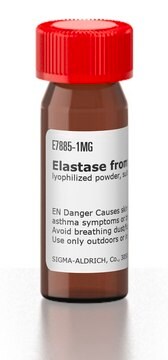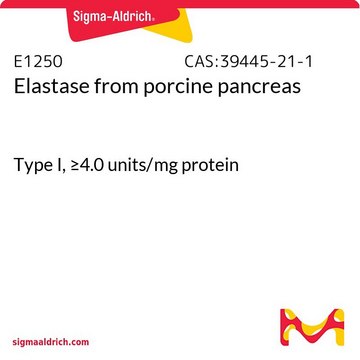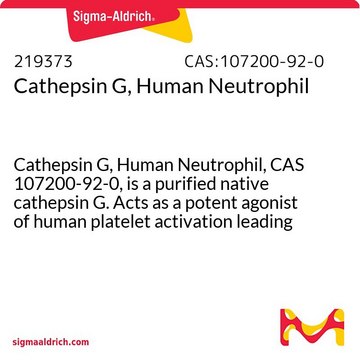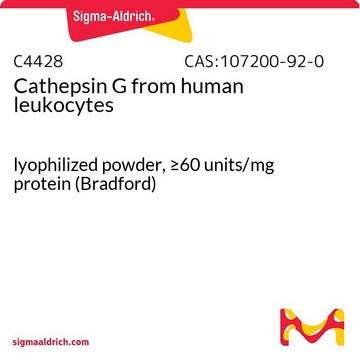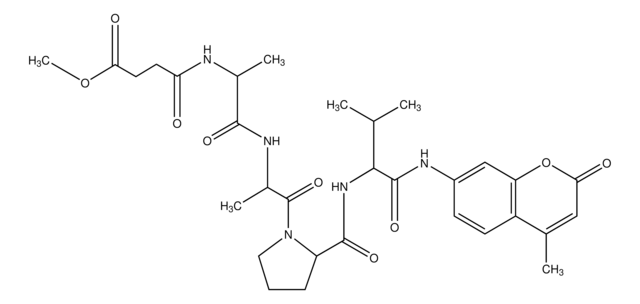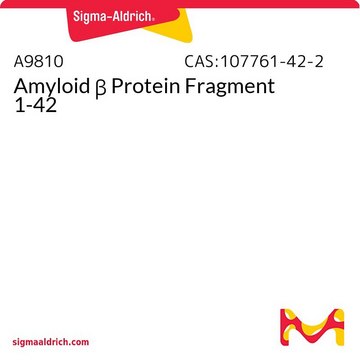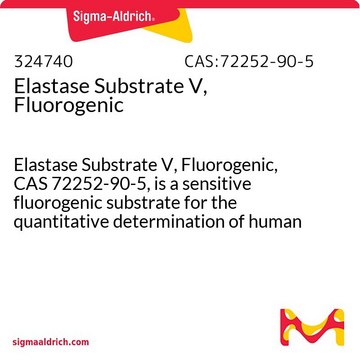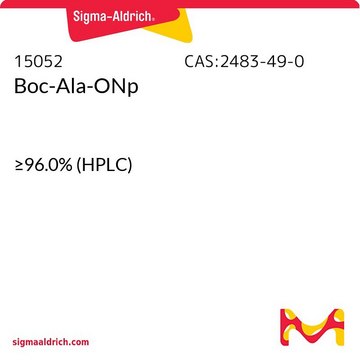E8140
Elastase from human leukocytes
lyophilized powder, ≥50 units/mg protein (Bradford)
Sinónimos:
Lysosomal elastase
Iniciar sesiónpara Ver la Fijación de precios por contrato y de la organización
About This Item
Número de CAS:
Número MDL:
Código UNSPSC:
12352204
NACRES:
NA.54
Productos recomendados
origen biológico
human leucocytes
Nivel de calidad
Formulario
lyophilized powder
actividad específica
≥50 units/mg protein (Bradford)
mol peso
29 kDa
Nº de acceso UniProt
Condiciones de envío
dry ice
temp. de almacenamiento
−20°C
Información sobre el gen
human ... ELA2(1991) , ELANE(1991)
¿Está buscando productos similares? Visita Guía de comparación de productos
Categorías relacionadas
Descripción general
Elastase is a proteolytic enzyme. It is a member of the subgroup named, peptidyl peptide hydrolases. It is a major anatomic constituent of arteries. It is mainly found in the pancreas and pancreatic juice of various birds and mammals. It is also present in human serum, granulocytes and erythrocytes.
Aplicación
Elastase from human leukocytes has been used:
- to measure serum elastase activity
- in proteolytic digestion of fibronectin and salivary glands
- in neutrophil elastase (NE) activity assay
- cell-free NE digestion of E-cadherin
- scratch wound assay
- in a study that determined that fragments of Nle3-angiotensin(1-7) accelerate healing in dermal models
Acciones bioquímicas o fisiológicas
Elastase enzyme is capable of releasing soluble peptides from insoluble elastin fibers with the help of a proteolytic process. It can stimulate disintegration of the axoneme with the help of adenosine triphosphate (ATP). Unlike pancreatic elastase the leukocyte enzyme has a preferential cleavage for the carboxyl side of valine, but will also cleave to a lesser extent after alanine. Natural substrates include elastin, cartilage proteoglycans, collagen types I, II, II and IV, and fibronectin.
Propiedades físicas
Leukocyte elastase is a 29 kDa serine endoprotease of the Proteinase S1 Family. It exists as a single 238 amino acid-peptide chain with four disulfide bonds. It contains two or thee N-linked glycans of variable composition which account for its three major isoforms.
Isoelectric point: pI = 8.77 - 9.55
Isoelectric point: pI = 8.77 - 9.55
Definición de unidad
One unit will release one nanomole of p-nitrophenol per sec from BOC-L-alanine p-nitrophenyl ester at pH 6.5 at 37 °C.
Forma física
Lyophilized from 0.05 M sodium acetate (pH 5.5) and 0.6 M NaCl
Aplicación
Referencia del producto
Descripción
Precios
Inhibidor
Referencia del producto
Descripción
Precios
sustrato
Referencia del producto
Descripción
Precios
Código de clase de almacenamiento
13 - Non Combustible Solids
Clase de riesgo para el agua (WGK)
WGK 1
Punto de inflamabilidad (°F)
Not applicable
Punto de inflamabilidad (°C)
Not applicable
Elija entre una de las versiones más recientes:
¿Ya tiene este producto?
Encuentre la documentación para los productos que ha comprado recientemente en la Biblioteca de documentos.
Los clientes también vieron
Koichiro Mihara et al.
The Journal of biological chemistry, 288(46), 32979-32990 (2013-09-21)
Neutrophil proteinases released at sites of inflammation can affect tissue function by either activating or disarming signal transduction mediated by proteinase-activated receptors (PARs). Because PAR1 is expressed at sites where abundant neutrophil infiltration occurs, we hypothesized that neutrophil-derived enzymes might
Carey A Hobbs et al.
American journal of physiology. Lung cellular and molecular physiology, 305(12), L990-L1001 (2013-10-15)
The epithelial sodium channel (ENaC) is responsible for Na(+) and fluid absorption across colon, kidney, and airway epithelia. Short palate lung and nasal epithelial clone 1 (SPLUNC1) is a secreted, innate defense protein and an autocrine inhibitor of ENaC that
III - Hydrolases
Enzymes of the Arterial Wall, 208-390 (1969)
Elastase: General Information1,2
Methods of Enzymatic Analysis, 2, 1041-1045 (1974)
Regulation of Dynein in Ciliary and Flagellar Movement
Dyneins, 366-393 (2012)
Chromatograms
application for HPLCNuestro equipo de científicos tiene experiencia en todas las áreas de investigación: Ciencias de la vida, Ciencia de los materiales, Síntesis química, Cromatografía, Analítica y muchas otras.
Póngase en contacto con el Servicio técnico
